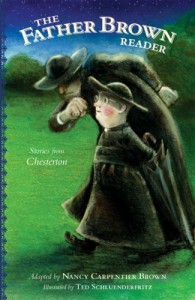Last week I set forth some reasons why older children (ages 12-18) have not outgrown the benefits of reading aloud. If you’re convinced about the why’s, you may be wondering about the how’s. Here are a few ideas along that line:
- Start early. If you’ve read to your kids as preschoolers, and after, they’ll be much more attuned to the idea and value of reading out loud as a family.
- Suppose you did start early but never thought you were very good at reading aloud and long books intimidate you. Remember that practice makes perfect, or at least better. Start with shorter books and shorter chapters, and you’ll get better as you go along. If your kids take turns with the reading, they’ll improve as well—and be glad of it.
- If you’ve let a few years go by since the last book you read aloud, the kids may wonder why you
 want to get back to it. If they seem reluctant, ask them what they’ve read recently that they’d like to share. What if Sean suggests The Diary of a Wimpy Kid? Well if nothing else, it’s funny, and you’ll find eager listeners (who may discover that they missed a lot while reading silently). And you can discuss the problems inherent in Greg Heffley’s behavior as you go along (but try not to do it in a moralizing way; let the listeners debate pros and cons of double-crossing your best friend). If Susan wants to read Goosebumps #476 next, humor them as far as you can—because then you can choose Anne of Green Gables. For the next round, tell Sean he’ll enjoy Holes, and suggest Lockwood & Company for Susan. Similar laughs and creepy thrills, but more literary value.
want to get back to it. If they seem reluctant, ask them what they’ve read recently that they’d like to share. What if Sean suggests The Diary of a Wimpy Kid? Well if nothing else, it’s funny, and you’ll find eager listeners (who may discover that they missed a lot while reading silently). And you can discuss the problems inherent in Greg Heffley’s behavior as you go along (but try not to do it in a moralizing way; let the listeners debate pros and cons of double-crossing your best friend). If Susan wants to read Goosebumps #476 next, humor them as far as you can—because then you can choose Anne of Green Gables. For the next round, tell Sean he’ll enjoy Holes, and suggest Lockwood & Company for Susan. Similar laughs and creepy thrills, but more literary value. - Keep in mind that we’re not talking about huge blocks of time here: half an hour at most, and 4-5 times per week.
- Even in half-hour increments, once the kids get involved with play practice and Awana and soccer games and part-time jobs, it’s a lot harder to find the time. You may have to choose a book to read during a season, rather than every week. Schedules seem to heat up in the fall and spring, so summer and winter may be your read-aloud seasons. Get the family together, ignore the eye-rolls, and try to agree on a regular time. It’s worth the effort.
- Take advantage of the down times. This is a no-brainer: a lot of families read aloud on long car trips, provided there’s someone who doesn’t get carsick (and in that case, audio books to the rescue). If it takes forty minutes to get to church or Tae Kwon Do, pack the book along. There may be times when family members are working quietly on individual projects, like crochet or quilting or whittling (though not cabinet-making). If you have a good strong voice, you could even read while they’re washing up after dinner. I used to read aloud when my kids were doing piecework for a retail business—which didn’t make as much money as they hoped, but at least we heard some good books.
- Pass it around. If you have kids who are dramatically inclined, pick a family-friendly novel and designate those family members who are willing to give it all they’ve got. After one reader has dramatically interpreted a few pages, pass the book on to the next. Put a lid on hamming, though—that sucks audience attention from the story. It might be fun for a while, but gets old fast.
- Try a readers theater. If you have more than one copy of a book, or can commandeer extra copies from the library, assign parts to each willing participant. One person will read all the narrative and “characters” will read the dialogue. This is great fun for Shakespeare plays! Though you’ll probably want to do some cutting first.
 Do we have book suggestions? Let me put that another way: Do we have book suggestions! Just last week, Hayley told us about five good family read alouds from days gone by. Try typing “read aloud” in our search box and browse the titles that come up. Search your memory for books you loved in your youth—wouldn’t you love to share some of those?
Do we have book suggestions? Let me put that another way: Do we have book suggestions! Just last week, Hayley told us about five good family read alouds from days gone by. Try typing “read aloud” in our search box and browse the titles that come up. Search your memory for books you loved in your youth—wouldn’t you love to share some of those?
Off the top of my head, here are some of the books I remember reading to my kids during those teen years, both fiction and nonfiction:
The Sword in the Stone, The Queen of Air and Darkness (Books One and Two of The Once and Future King)
To Kill a Mockingbird (natch)
Watership Down (can’t get through it without crying)
The Hobbit
A Walk across America and The Walk West (Peter Jenkins’ real-life adventure)
Peace Child by Don Richardson (missionary adventures in Papua New Guineau)
C. S. Lewis’s Space Trilogy (I made some cuts in the long expository passages)
The Robe by Lloyd C. Douglas
Honey for a Teen’s Heart, by Gladys Hunt and Barbara Hampton, includes hundreds of suggestions, all tried and true. For inspiration and motivation, visit Read Aloud Revival and listen to some podcasts. Jim Weiss, storyteller and read-alouder extraordinaire, shared some tips with our own Megan Saben; be sure to read what he had to say. Make a midwinter resolution to try it just for a few months—schedule some times, and see what happens. And, as always, please share your own read-aloud tips and suggestions in the comments!
Stay Up to Date!
Get the information you need to make wise choices about books for your children and teens.
Our weekly newsletter includes our latest reviews, related links from around the web, a featured book list, book trivia, and more. We never sell your information. You may unsubscribe at any time.
Support our writers and help keep Redeemed Reader ad-free by joining the Redeemed Reader Fellowship.
Stay Up to Date!
Get the information you need to make wise choices about books for your children and teens.
Our weekly newsletter includes our latest reviews, related links from around the web, a featured book list, book trivia, and more. We never sell your information. You may unsubscribe at any time.
We'd love to hear from you!
Our comments are now limited to our members (both Silver and Golden Key). Members, you just need to log in with your normal log-in credentials!
Not a member yet? You can join the Silver Key ($2.99/month) for a free 2-week trial. Cancel at any time. Find out more about membership here.
1 Comments
Leave a Comment
You must be logged in to post a comment.


My favorite anecdote from a children’s literature professor was that she and her husband agreed that one of them would do the dishes and the other would read aloud. She persuaded him that she was the better reader! 🙂